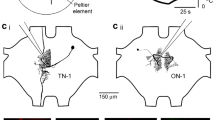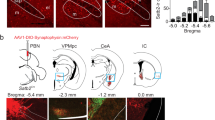Summary
-
1.
Bilaterally paired ventral white cells (VWCs) in the buccal ganglion ofPleurobranchaea are putative command neurons which in part derive their ability to drive the neural network controlling the buccal mass from the progressive broadening of action potentials during repetitive firing (Fig. 1) (Gillette et al. 1978, 1980). We have conducted an investigation of the parameters and mechanisms of spike broadening using conventional intracellular recording methods, ion substitutions, intracellular injections, and pharmacological agents. In the course of these studies we found evidence for a role for [Ca++]i in modulating spike broadening.
-
2.
During a current-driven train of broadening spikes, the overshoot amplitudes initially increase progressively and then decline. The rate of broadening is slowest during growth of the overshoot and maximal during overshoot decline (Fig. 2), suggesting that changes in overshoot amplitude contribute to spike broadening. However, a continuous decline in spike undershoot amplitudes throughout the train suggests a relation between the factors underlying progressive spike broadening and progressive decline of undershoot (Fig. 3).
-
3.
Progressive spike broadening is dependent on the presence of external Ca++ (Fig. 4), indicating that late Ca++ current supports the prolonged depolarization of the broadened spike. In contrast, the progressive decay of the amplitudes of the K+-dependent undershoots is not dependent on external Ca++ (Fig. 5). Tetraethylammonium ion (TEA) applied extracellularly or injected intracellularly causes extreme spike prolongation (Fig. 6), indicating the presence of the delayed K+ current known to inactivate with depolarization in other molluscan neurons (Aldrich et al. 1979a). Both by analogy with a previous study of spike broadening (Aldrich et al. 1979b) and direct ly, these data suggest that spike broadening during repetitive firing is largely due to a progressive decrease in a delayed K+ current, which thus permits spike prolongation by inward Ca++ current.
-
4.
While the major contribution to spike broadening appears to arise from decrement of the TEA-sensitive K+ current, internal Ca++ levels appear to have a significant role in modulating the rate and extent of spike broadening. This role may be effected through a Ca++-activated K+ current (I K,Ca ), and possibly by regulation of the Ca++ conductance itself.I K,Ca is demonstrable in the undershoots of single, unbroadened action potentials, whose waveforms and amplitudes are affected by agents and treatments known to suppressI K,Ca (low Ca++, Ba++, Co++, and injections of EGTA) or enhance it (high Ca++, high Ca++-buffer injection) (Figs. 7, 8, 9 and 10).
-
5.
Intracellular injection of the Ca++ chelator, EGTA, or replacement of external Ca++ by Ba++ enhances progressive spike broadening (Fig. 11). Conversely, intracellular injection of high Ca++ (EGTA) buffers suppresses broadening (Figs. 12 and 13). These experiments suggest a possible role for intracellular Ca++ regulation in modulating this form of functional neuronal plasticity (Fig. 14).
Similar content being viewed by others
Abbreviations
- TEA :
-
tetraethylammonium
- VWC :
-
ventral white cell
References
Ahmed Z, Connor JA (1979) Measurement of calcium influx under voltage clamp in molluscan neurones using the metallochromic dye Arsenazo III. J Physiol (Lond) 286:61–82
Aldrich RW, Getting PA, Thompson SH (1979a) Inactivation of delayed outward current in molluscan neurone somata. J Physiol (Lond) 291:507–530
Aldrich RW, Getting PA, Thompson SH (1979b) Mechanism of frequency-dependent broadening of molluscan soma spikes. J Physiol (Lond) 291:531–544
Atwater I, Dawson CM, Ribalet B, Rojas E (1979) Potassium permeability activated by intracellular calcium ion concentration in the pancreatic β-cell. J Physiol (Lond) 288:575–588
Carew TJ, Kandel ER (1977) Inking inAplysia californica. J Neurophysiol 40:692–734
Castelucci V, Pinsker H, Kupfermann I, Kandel ER (1970) Neuronal mechanisms of habituation and dishabituation of the gillwithdrawal reflex inAplysia. Science 167:1745–1748
Connor JA (1979) Calcium current in molluscan neurones: measurement under conditions which maximize its visibility. J Physiol (Lond) 286:41–60
Connor JA, Stevens CF (1971a) Inward and delayed outward membrane currents in isolated neural somata under voltage clamp. J Physiol (Lond) 213:1–19
Connor JA, Stevens CF (1971b) Voltage clamp studies of a transient outward membrane current in gastropod neural somata. J Physiol (Lond) 213:21–30
Davis WJ, Gillette R (1978) Neural correlates of behavioral plasticity in command neurons ofPleurobranchaea. Science 199:801–804
Eckert R, Lux WD (1975) A non-inactivating inward current recorded during small depolarizing voltage steps in snail pacemaker neurons. Brain Res 83:486–489
Eckert R, Tillotson D (1978) Potassium activation associated with intraneuronal free calcium. Science 200:437–439
Getting PA, Lennard PR, Hume RI (1980) Central pattern generator mediating swimming inTritonia. Identification and synaptic interactions. J Neurophysiol 44:151–164
Gillette MU, Gillette R, Davis WJ (1978a) Cyclic AMP may modulate prolonged endogenous bursting and spike broadening in the ventral white cell ofPleurobranchaea. Soc Neurosci Abstr 4:1209
Gillette R, Kovac MP, Davis WJ (1978b) Command neurons inPleurobranchaea receive synaptic feedback from the motor network they excite. Science 199:798–801
Gillette R, Gillette MU, Davis WJ (1978c) Prolonged endogenous bursting and spike broadening are substrates of command function in the feeding network ofPleurobranchaea californica. Soc Neurosci Abstr 4:1210
Gillette R, Gillette MU, Davis WJ (1980) Action potential broadening and endogenously sustained bursting are substrates of command ability in a feeding neuron ofPleurobranchaea. J Neurophysiol 43:669–685
Gillette R, Gillette MU, Davis WJ (1982) Substrates of command ability in a buccal neuron ofPleurobranchaea: II. Potential role of cyclic AMP. J Comp Physiol 146:461–470
Gola M (1976) Electrical properties of bursting pacemaker neurones. In: Salanki J (ed) Neurobiology of invertebrates. Plenum, New York, pp 381–423
Gorman ALF, Marmor AF (1970) Temperature dependence of the sodium-potassium permeability ratio of a molluscan neurone. J Physiol (Lond) 210:919–931
Gorman ALF, Thomas MV (1978) Changes in the intracellular concentration of free calcium ions in a pace-maker neurone, measured with the metallochromic indicator dye Arsenazo III. J Physiol (Lond) 275:357–376
Gorman ALF, Thomas MV (1980) Potassium conductance and internal calcium accumulation in a molluscan neurone. J Physiol (Lond) 308:287–313
Hagiwara S, Fukuda J, Eaton DC (1974) Membrane currents carried by Ca, Sr, and Ba in barnacle muscle fibers during voltage clamp. J Gen Physiol 63:564–578
Hermann A, Gorman ALF (1981) Effects of Tetraethylammonium on potassium currents in a molluscan neuron. J Gen Physiol 78:87–110
Hodgkin AL, Huxley AF (1952) A quantitative description of membrane current and its application to conduction and excitation in nerve. J Physiol (Lond) 117:500–544
Kaczmarek LK, Strumwasser F (1981) The expression of long lasting after discharge by isolatedAplysia bag cell neurons. J Neurosci 1:626–634
Klein M, Kandel ER (1978) Presynaptic modulation of voltage-dependent Ca+2 current: Mechanism for behavioral sensitization inAplysia californica. Proc Natl Acad Sci USA 75:3512–3516
Kostyuk PG, Krishtal OA (1977) Effects of calcium and calcium chelating agents on the inward and outward current in the membrane of mollusc neurons. J Physiol (Lond) 270:569–580
Kupferman I (1970) Stimulation of egg-laying by extracts of neuronendocrine cells (bag cells) of abdominal ganglion ofAplysia. J Neurophysiol 33:877–881
Meech RW (1974a) Prolonged action potentials inAplysia neurones injected with EGTA. Comp Biochem Physiol [A] 48:397–402
Meech RW (1974b) The sensitivity ofHelix aspersa to injected calcium ions. J Physiol (Lond) 237:259–277
Meech RW (1978) Calcium-dependent potassium activation in nervous tissues. Annu Rev Biophys Bioeng 7:1–18
Meech RW, Standen NB (1975) Potassium activation inHelix aspersa neurons under voltage clamp: a component mediated by calcium influx. J Physiol 249:211–239
Pinsker W, Kupfermann I, Castelucci V, Kandel ER (1970) Habituation and dishabituation of the gill-withdrawal reflex inAplysia. Science 167:1740–1742
Requena J, Dipolo R, Brinley FJ Jr, Mullins LJ (1977) The control of ionized calcium in squid axons. J Gen Physiol 70:329–353
Siegler MVS, Mpitsos GP, Davis WJ (1974) Motor organization and generation of rhythmic feeding output in the buccal ganglion ofPleurobranchaea. J Neurophysiol 37:1173–1196
Standen NB (1975) Voltage clamp studies of the calcium inward current in an identified snail neurone: comparison with the sodium inward current. J Physiol (Lond) 249:253–268
Stinnakre J, Tauc L (1973) Calcium influx in activeAplysia neurons detected by injected aequorin. Nature 242:113–115
Taghert PH, Willows AOD (1978) Control of a fixed action pattern by single, central neurons in the marine mollusk,Tritonia diomedea. J Comp Physiol 123:253–259
Thompson SH (1977) Three pharmacologically distinct potassium channels in molluscan neurons. J Physiol (Lond) 265:465–488
Author information
Authors and Affiliations
Rights and permissions
About this article
Cite this article
Gillette, R., Gillette, M.U. & Davis, W.J. Substrates of command ability in a buccal neuron ofPleurobranchaea . J. Comp. Physiol. 146, 449–459 (1982). https://doi.org/10.1007/BF00609441
Accepted:
Issue Date:
DOI: https://doi.org/10.1007/BF00609441




